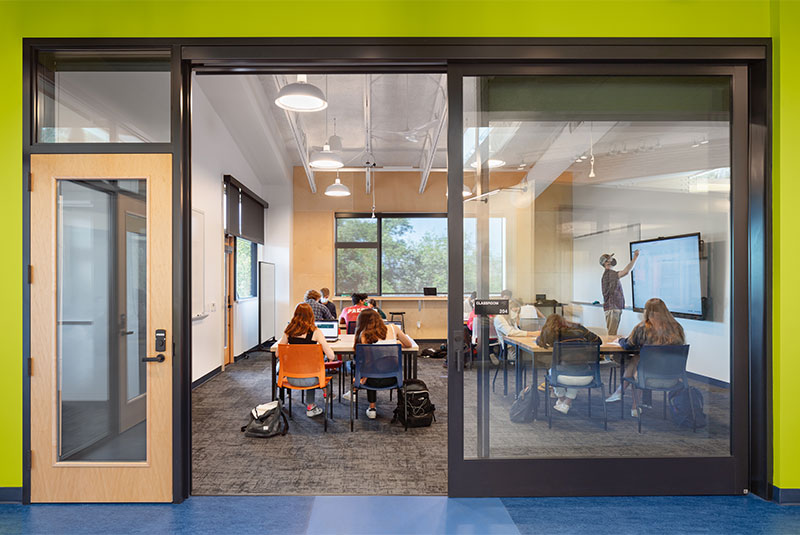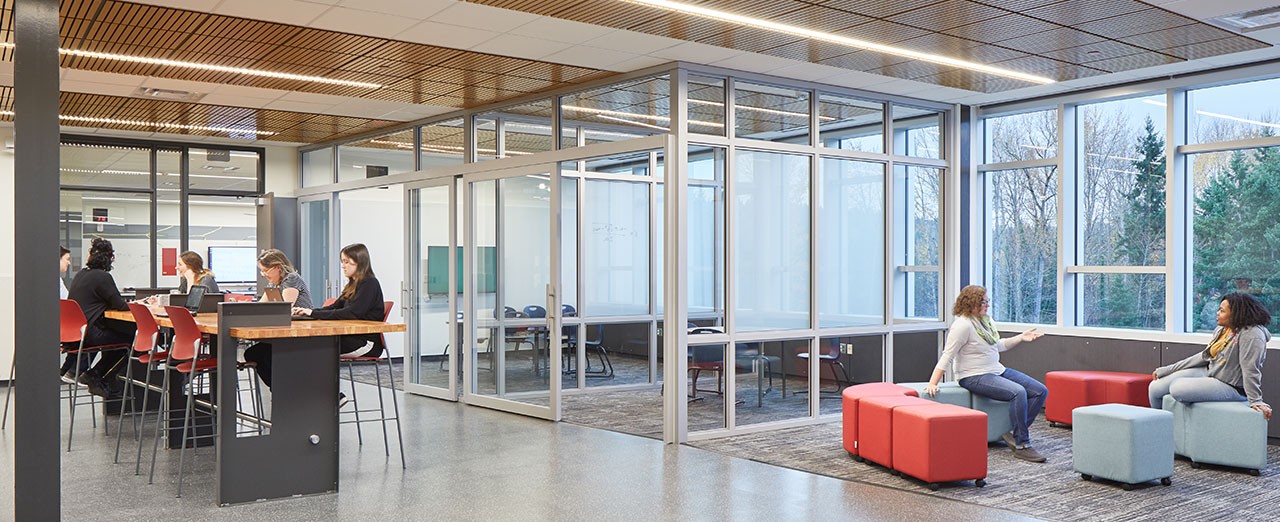
Soft-close sliding doors can play a crucial role in facilitating learning and student growth. While sliding doors can be used in a variety of contexts, how they benefit school settings is most apparent in classrooms, break out zones and teacher planning areas. The following will explore how these three areas can help improve educational design.
Flexible design in the classroom
Soft-close sliding doors support flexible learning space design by eliminating swing arc trajectories. This means that no matter the size of the door, no space will be taken up if it is left open. As such, teachers can open doors, allowing the classroom and adjacent areas to function as one large space without impeding foot traffic or having to rearrange desks and chairs. The flexibility this achieves helps facilitate activities that benefit from larger spaces or more fluid classroom layouts.
In Ojai, Cali., the Thacher School utilized eight oversized sliding doors to increase the effectiveness of classroom design. These doors allowed educators to utilize the space in a way that worked best for their students and allowed a range of lesson plans—from informal lectures to activities that require movement. Planning flexible learning spaces, according to Blackbird Architects (the firm behind the project), was vital to the design, so it was important that the doors specified for the school could fulfill all the needs of the space, including acoustic isolation.
Acoustic isolation for concentrated study areas
In addition to classroom design, it’s important that educational settings have break out zones that support independent and group study. However, potential distractions can derail the goal of these rooms—including noise from neighboring hallways and spaces. While all students can benefit from fewer distractions during concentrated study, students with learning disabilities may experience greater benefits from a space that is acoustically isolated from busier areas.
Soft-close sliding doors can be installed with acoustic jamb gaskets and drop-down bottom seals for premium sound performance. In fact, several doors from AD Systems incorporate these features to achieve Noise Isolation Class (NIC) ratings of up to 39. This means they can stop 39 decibels from bleeding into study areas, effectively dampening normal conversation to a murmur.
Juanita High School in Kirkland, Wash., saw the benefits this feature provided and integrated sliding doors into several breakout spaces to give students options for distraction-free independent study. Likewise, these spaces can be used for small group work or meetings with para-educators since the acoustic seals stop sound from disturbing occupants in adjacent spaces as well. North Creek High School in Bothell, Wash., incorporated the doors in several flexible learning spaces on campus.
Soft-close sliding doors support student-teacher relations
In addition to the collaboration cubes, North Creek High School also utilized sliding doors in four teacher planning rooms. The doors for the cubes and planning areas sport large lites of glass, which improve the visual connection between spaces and people. Teachers can monitor and assist students in collaboration cubes without encroaching on their need for solitude. And students can approach teachers in planning areas should they need help outside of class.
The result is an educational setting with a welcoming, open-door policy that strengthens the relationship between students and teachers. In this way, soft-close sliding doors help ensure that students and teachers can connect and that learning can happen nearly everywhere on campus.
Flexible learning space design supports all students
Soft-close sliding doors can be used throughout an educational environment. However, using them for classrooms, break out zones and teacher planning areas can improve the effectiveness of school design and support student outcomes. Whether used to accommodate flexible learning spaces, mitigate distractions during independent study or improve student-teacher relationships, sliding doors can play an integral role in actualizing the research being conducted on EBD in educational settings.







